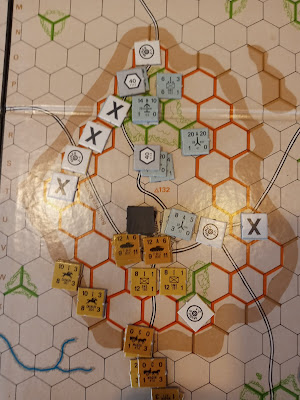Promises simultaneous movement and combat. I hope it doesn't bust the game's simple mechanics. One of the strong points of RW is fast set up and fast play.This variant from David A. Bottger gets high praise from the editor at the General, Avalon Hill’s house organ for their line of classic wargames. The main feature of this variant is simultaneous movement and firing. The game turn changes from an IGO-UGO
move and fire schedule so a game turn is only 1 segment instead of 2 segments per RAW. What this gives a pilot in the game is an edge to the one who knows their plane the best. In ariel combat absolute understanding of your plane’s capabilities is an essential ingredient for survival. To me this means the variant is off to a very promising start.
The other feature is “Tailing”. This returns the real-life advantage
of being on your enemy’s 6 to anticipate their move and line up your shot for
the kill. Awesome. The tailing mechanic is a target number set by position, range,
and the two plane’s maneuver schedules. Degree of success determines the percentage
of the tailed plane’s plotted movement which must be revealed to the tailing
pilot. This information should be limited to the players/pilots involved because
WWI craft had no radios. From my first read through of the variant I do not
believe there is a limit to the number of planes which can tail a target and
the tailer can be jumped and tailed by other enemy craft at the same time. Getting
even better!
Take note, the field of fire is no longer limited to a
straight line out from the front of your plane. It has been increased to a 60
degree front-facing arc. This is to compensate for the difficulty of getting directly
in line for your shot when there is guess work in where you and your opponent
is going to end up at the end of the movement phase. I do not know if this is necessary,
but we will go with it for now. I anticipate much more shooting in this variant
then regular play.
Unexpected Maneuvers are expected to be used. But unlike Flying Lessons the author gives very clear instructions on their use. I am now going to set up the first scenario again and run through some turns to reach a verdict on this variant. Does it enhance, does it detract, does it play with little or no ambiguity? I set the pieces on the board differently than the previous game, but it does not change the start of the game much. The planes are shooting at each other in the first turn! I messed around with different throttle settings in the previous game to see the effect. I came to the conclusion speed is king. All planes in this start come out full throttle with no intention of letting up. The Sopwith Camel has a top throttle speed of 10 and the Fokker Dr 1 is 9. The Fokker can climb and dive farther than the Sopwith in a turn, but all in all these two planes are an even match. I see the Fokkers climbing and diving in this match up much more than the previous run.
Top of turn 3 and we are looking at our first tailing opportunity.
Sop2 forgoes shooting at the Baron who is right close and picks a Fokker
farther out flying away from the Sops ten o’clock as its target. With the
increased distance the Sop is increasing its chances of a successful tail. The
fire resolution is a miss and reading the tailing rules closely I find the Allied
plane is too far away to force the tailing rules on its opponent. Everybody
plots their moves in secret!
The rules are all working fine with little to no ambiguities. It is easy to see how and when you can perform a special maneuver. There are easy to assess attack modifiers which consider angle of attack, speed, Ace status and the like. The tailing rules make a great substitute for the RAW spotting rules. Side-Slips and Barrel Rolls and Loops keep the action tight.
And I don’t like it as much as the “Flying Lessons” variant. What is up with that? It is the ease of maneuver, which is also present in RAW, the planes can produce. The previous variant locks you in to a left, right or straight flight path for your entire movement. But if you start receiving a hail of bullets the variant asks you to bust out the Unexpected Maneuvers schedule or pull extreme Gs to roll out of a certain death tailing situation. I may be frustrated with the holes, the vagueness in the rule interpretations for the Flying variant, but pulling the stick and shifting the rudder to set up my attack run was more fun. I didn’t notice a difference in firing chances either, which you would expect because “Advanced” increases the arc of fire. The Flying Lessons variant remains true to the RAW, your firing arc is directly ahead. While the Advanced must add an additional rule to shooting your guns to cover the flexible maneuver abilities, the Flying variant forces you to target more carefully. But I had just as many firing chances during the session. Go figure.














